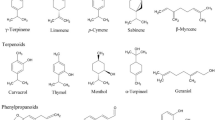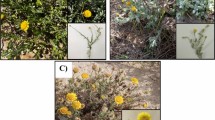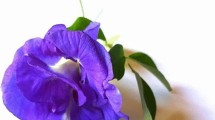Abstract
Bottle gourd (Lagenaria siceraria) belongs to the family Cucurbitaceae, which comprises about 118 genera and 825 species. It is an important vegetable crop of India, and its production is influenced by a number of factors viz., environmental, nutritional, cultural operation and use of plant growth regulators. Since, bottle gourd belongs to a medicinal family, it plays a major role in the treatment of several diseases related to the skin and heart. There are several organic chemical compounds including vitamin B complex, pectin, dietary soluble fibres, ascorbic acid, beta-carotene, amino acids and minerals which have been isolated from this species. Therefore, the bottle gourd is considered to have a great impact on therapeutic health benefits. Due to drastic industrialization and urbanization, most of the human beings are facing several ill effects which may lead to death at extreme cases. Hence, the major research area was said to be nanotechnology. Taking into consideration, we have combined nanotechnology field with waste source in the name of green synthesis and planned to cure several diseases, as most of the researchers focused their work on this and succeeded too. The present study is a complete review of L. siceraria that covers the ethnomedical uses, chemical constituents, and pharmacological profile. This study is mainly focused on the antibacterial, hepatoprotective, diuretic and anthelminthic activities.







Similar content being viewed by others
References
Adedapo A, Adewuyi T, Sofidiya M (2013) Phytochemistry, anti-inflammatory and analgesic activities of the aqueous leaf extract of Lagenaria breviflora (Cucurbitaceae) in laboratory animals. Int J Trop Biol 61:281–290
Agrawal S, Katare C (2015) Antioxidant activity, total phenolic compound and flavonoid content of vacuum dried extract of L. siceraria. Global J Multi Studies 4:302–308
Anandh B, Muthuvel A, Emayavaramban A (2014) Bio synthesis and characterization of silver nanoparticles using Lagenaria siceraria leaf extract and their antibacterial activity. Int Lett Chem Phys Astron 19:35–45
Antia SB, Essien E, Udoh B (2015) Antioxidant capacity of phenolic from seed extracts of Lagenaria siceraria (short-hybrid bottle gourd). Euro J Med Plants 9:1–9
Avinash K, Abha D, Ganesh SN (2011) Peptic ulcer: a review with emphasis on plants from Cucurbitaceae family with an antiulcer potential. Int J Res Ayurveda Pharma 2:1714–1716
Bar H, Bhumi KR, Sahoo GP, Sarkar P, Sankar PD (2009) Green synthesis of silver nanoparticles using latex of Jatropha curcas. Colloids Surf A 39:134–139
Bendi R, Imae T (2013) Renewable catalyst with Cu nanoparticles embedded into cellulose nano-fiber film. RSC Adv 3:16279–16282
Bharathi A, Roopan SM, Kajbafvala A, Padmaja RD, Darsana MS, Kumari GN (2014a) Catalytic activity of TiO2 nanoparticles in the synthesis of some 2,3-disubstituted dihydroquinazolin-4(1H)-ones. Chin Chem Lett 25:324–326
Bharathi A, Roopan SM, Vasavi CS, Gayathri GA, Gayathri M (2014b) In silico molecular docking and in vitro antidiabetic studies of dihydropyrimido[4,5-a]acridin-2-amines. Biomed Res Inter 971569:1–10
Bhattacharya S, Das B (2012) Anti-diabetic activity of Lagenaria siceraria pulp and seed extract in normal and alloxan-induced diabetic rats. Int J Pharm Sci Res 3:3362–3369
Bisogenin DA (2002) Origin and evolution of cultivated cucurbits. Ciencia Rural 32:715–723
Chanda S, Moteriya P, Padalia H, Rathod T, Baravalia Y (2015) Antioxidant and metal chelating activities of Lagenaria siceraria (Molina) Standl peel, pulp and aerial parts in relation to their total phenol and flavonoid content. Pharmacog J 7:64–73
Charu K, Sonali S, Supriya A, Prasad GBKS (2013) Alleviation of diabetes induced dyslipidemia by Lagenaria siceraria fruit extract in human type 2 diabetes. J Herb Med 3:1–8
Chauhan N, Dahiya T, Priyanka PCS (2010) Fabrication of an amperometric ascorbate biosensor using egg shell membrane bound Lagenaria siceraria fruit ascorbate oxidase. J Mol Catal B 67:66–71
Erickson D, Smith BD, Clark AC, Sandweiss DH, Tuross N (2005) An Asian origin for a 10000-year-old domesticated plant in the Americas. Proc Natl Acad Sci U S A 102:18315–18320
Ghosh K, Chandra K, Ojha AK, Sarkar S, Islam SS (2009) Structural identification and cytotoxic activity of a polysaccharide from the fruits of Lagenaria siceraria (Lau). Carbohydrate Res. 344:693–698
Ghule BV, Ghante MH, Yeole PG, Saoji AN (2003) Diuretic activity of Lagenaria siceraria fruit extracts in rats. Indian J Pharm Sci 69:817–819
Ghule BV, Ghante MH, Saoji AN, Yeole PG (2009) Antihyperlipidemic effect of the methanolic extract from Lagenaria siceraria stand. Fruit in hyperlipidemic rats. J Ethnopharmacol 124:333–337
Gill NS, Singh S, Arora R, Bali M (2012) Evaluation of ethanolic seed extract of Lagenaria siceraria for their therapeutic potential. J Med Sci 12:78–84
Gonzalez AL, Noguezm C (2007) Influence of morphology on the optical properties of metal nanoparticles. J Comput Theor Nanos 4:231–238
Goyal BR, Goyal RK, Mehta AA (2007) Phyto-pharmacology of Achyranthes aspera. A review. Pharmacogn Rev 1:143–150
Habib-ur-Rahaman AS (2003) Bottle gourd (Lagenaria siceraria)—a vegetable for good health. Nat Prod radiance 2:249–256
Hemalatha K, Madhumitha G, Kajbafvala A, Anupama N, Sompalle R, Roopan SM (2013) Function of nanocatalyst in chemistry of organic compounds revolution: an overview. J Nanomat 341015:1–23
Jayaseelan C, Rahuman AA, Roopan SM, Kirthi AV, Venkatesan J, Kim SK, Iyappan M, Siva C (2013) Biological approach to synthesize TiO2 nanoparticles using Aeromonas hydrophila and its antibacterial activity. Specrochim Acta A 107:82–89
Kalaiselvi A, Roopan SM, Madumitha G, Ramalingam C, Elango G (2015) Synthesis and characterization of palladium nanopparticles using Catharanthus roseus leaf extract and its application in the photo-catalycic degradation. Spectrochim Acta A 135:116–119
Kalpna R, Mital K, Sumitra C (2011) Vegetable and fruit peels as a novel source of antioxidants. J Med Plants Res 5:63–71
Kamaraj C, Rahuman AA, Roopan SM, Marimuthu S, Kirthi AV (2014) Bioassay guided isolation and characterization of active antiplasmodial compounds from Murraya koenigii extracts against Plasmodium falciparum and Plasmodium berghei. Parasitol Res 113:1657–1672
Killedar SG, Mahamuni SS, Nivruti H, Gadakari SS, Nale AB, Pawar AA (2012) Phytochemical investigation and cytotoxic screening of Lagenaria siceraria fruit using brine shrimp lethality assay models. Int J Pharm Chem Biol Sci 2:422–426
Koffi D, Faule B, Gonnety J, Bédikou M, Kouamé L, Zoro I, Niamké S (2010) Biochemical characterization of phosphatase, -galactosidase and -mannosidase activities of seeds of an oleaginous cucurbit: Lagenaria siceraria (Molina) standl blocky-fruited cultivar. Sci Nat 2:221–235
Kumar A, Partap S (2012) In vitro anthelmintic activity of Lagenaria siceraria leaves in Indian adult earthworm. J Pharmaco Phytochem 1:39–42
Kumar DA, Palanichamy V, Roopan SM (2014) Green synthesis of silver nanoparticles using Alternanthera dentata leaf extract at room temperature and their antimicrobial activity. Spectrochim Acta Part A 127:168–171
Kumari N, Tajmul M, Yadav S (2015) Proteomic analysis of mature Lagenaria siceraria seed. Appl Biochem Biotechnol 175:3643–3656
Madhumitha G, Roopan SM (2013) Devastated crops: multifunctional efficacy for the production of nanoparticles. J Nanomat 951858:1–12
Madhumitha G, Saral AM (2009) Free radical scavenging assay of Thevetia nerüfolia leaf extracts. Asian J Chem 21:2468–2470
Madhumitha G, Rajakumar G, Roopan SM, Rahuman AA, Priya KM, Saral AM, Khan FN, Khanna VG, Velayutham K, Jayaseelan C, Kamaraj C, Elango G (2012) Acaricidal, insecticidal, and larvicidal efficacy of fruit peel aqueous extract of Annona squamosa and its compounds against blood-feeding parasites. Parasitology Res 111:2189–2199
Madhumitha G, Elango G, Roopan SM (2015) Bio-functionalized doped silver nanoparticles and its antimicrobial studies. J sol-gel sci Tech 73:476–483
Mali VR, Bodhankar SL (2010) Cardioprotective effect of Lagenaria siceraria (LS) fruit powder in isoprenalin-induced cardiotoxicity in rats. Eur J Integr Med 2:143–149
Mali VR, Mohan V, Bodhankar SL (2012) Antihypertensive and cardioprotective effect of the Lagenaria siceraria fruit in NG-nitro-l-arginine methyl ester (l-NAME) induced hypertensive rats. Pharm Biol 50:1428–1435
Mayakrishnan V, Veluswamy S, Sundaram KS, Kannappan P, Abdullah N (2012) Free radical scavenging potential of Lagenaria siceraria (Molina) standl fruits extract. Asian Pac J Trop Med 6:20–26
Menpara D, Desai D, Rathod T, Chanda S (2014) Evaluation of nutraceutical bottle gourd (Lagenaria siceraria) as a potential source of natural antimicrobial agent. Am J Phytomedicine Clin Ther 2:375–389
Mohan R, Birari R, Karmase A, Jagtap S, Bhutani KK (2012) Antioxidant activity of a new phenolic glycoside from Lagenaria siceraria stand. J Agric Food Chem 132:244–251
Nalwade AR, Shinde SS, Bhor GL, Admuthe NM, Shinde SD, Gawade VV (2013) Rapid biosynthesis of silver nanoparticles using bottle gourd fruit extract and potential application as bactericide. Res Pharm 3:22–28
Nithya P, Khan FN, Roopan SM, Sankar U, Jin JS (2011) Environmentally benign one pot synthesis and antimicrobial activity of 1-methyl-2,6-diarylpiperidin-4-ones. Chem Pap 65:743–746
Ogunbusola EM, Fagbemi TM, Osundahunsi OF (2010) Amino acid composition of Lagenaria siceraria seed flour and protein fractions. J Food Sci Tech 6:656–661
Parashar V, Parashar R, Sharma B, Pandey AC (2009) Parthenium leaf extract mediated synthesis of silver nanoparticles: a novel approach towards weed utilization. Digest J Nanomater Biostruct 4:45–50
Rahman AS (2003) Bottle gourd (Lagenaria siceraria): a vegetable for good health. Nat Prod rad 2:249–250
Ramaraju B, Imae T, Destaye AG (2015) Ag nanoparticle-immobilized cellulose nanofibril films for environmental conservation. Appl Cat A 492:184–189
Roopan SM, Elango G (2015) Exploitation of Cocos nucifera a non-food toward the biological and nanobiotechnology field. Ind Crop Prod 67:130–136
Roopan SM, Khan FN (2010) ZnO nanoparticles in the synthesis of AB ring core of camptothecin. Chem Pap 64:812–817
Roopan SM, Khan FN (2011) SnO2 nanoparticles mediated nontraditional synthesis of biologically active 9-chloro-6,13-dihydro-7-phenyl-5H-indolo[3,2-c]acridine derivatives. Med Chem Res 20:732–737
Roopan SM, Madhumitha G (2013) Multifunctional efficacy for the production of nanoparticles. J Nanomat 951858:1–12
Roopan SM, Khan FN, Jin JS, Kumar RS (2011) An efficient one pot three component cyclocondensation in the synthesis of 2-(2-chloroquinolin-3-yl)-2,3-dihydroquinazolin-4(1H)-ones. Res Chem Inter 37:919–927
Roopan SM, Bharathi A, Kumar R, Khanna VG, Prabhakarn A (2012a) Acaricidal, insecticidal and larvicidal efficacy of aqueous extract of Annona squamosa L peel as biomaterial for the reduction of palladium salts into nanoparticles. Colloids Surf B 92:209–212
Roopan SM, Bharathi A, Prabhakarn A, Rahuman AA, Velayutham K, Rajakumar PRD, Lekshmi M, Madhumitha G (2012b) Efficient phyto-synthesis and structural characterization of rutile TiO2 nanoparticles using Annona squamosa peel extract. Spectrochim Acta A 98:86–90
Roopan SM, Rohit MG, Rahuman AA, Kamaraj C, Bharathi A, Surendra TV (2013) Low-cost and ecofriendly phytosynthesis of silver nanoparticles using Cocos nucifera coir extract and its larvicidal activity. Ind Crop Prod 43:631–635
Roopan SM, Surendra TV, Elango G, Kumar SHS (2014) Biosynthetic trends and future aspects of bimetallic nanoparticles and its medicinal applications. Appl Micro Biotech 98:5289–5300
Saha PU, Mazumder UK, Haldar PK, Islam A, Suresh Kumar RB (2011) Evaluation of acute and subchronic toxicity of Lagenaria siceraria aerial parts. Int J Pharm Sci Rev Res 2:1507–1512
Satvir S, Gill NS, Arora R (2012) Study the antioxidant activity of Lagenaria siceraria seeds. Int J Nar Prod Sci 1:224
Sen CK, Paul B, Biswas BK, Shahid-Ud-Daula AFM (2013) Cytotoxic effect of Lagenaria siceraria crude extracts obtained from its flowers. Int J Phyto Res 3:15–21
Sen CK, Binita P, Biswas BK, Shahid-Ud-Daula AFM (2014) Antimicrobial activity of Lagenaria siceraria crude extracts obtained from its flowers. Int J Pharmacog 6:780–784
Sharma NK, Yadav P, Singh HM, Shrivastava AK (2013) In vitro antioxidant activity of Lagenaria siceraria leaves. Malay J Pharm Sci 11:1–11
Shirsat SD, Kadam AS (2015) Analysis of tissue specific digestive and antioxidant enzymes from Cucurbita pepo and Lagenaria siceraria (molina) standl. Int J App Bio Pharm Tech 6:58–67
Shrivastava A, Roy S (2013) Cucurbitaceae: an ethnomedicinally important vegetable family. J Med Plants Stud 1:16–20
Singh MK, Mohd F, Ayaza A, Ankura S, Jyotia Y (2012) Protective effect of Lagenaria siceraria against doxorubicin induced cardiotoxicity in wistar rats. Int J Drug Dev Res 4:298–305
Sokoto MA, Hassan LG, Salleh SE, Dangoggo SM, Ahmad HG (2013) Quality assessment and optimization of biodiesel from Lagenaria vulgaris (calabash) seeds oil. Int J Pure Appl Sci Technol 15:55–66
Sood A, Kaur P, Gupta R (2012) Phytochemical screening and antimicrobial assay of various seeds extract of Cucurbitaceae family. Int J App Bio Pharm Tech 3:401–409
Teugwa CM, Boudjeko T, Tchinda BT, Mejiato PC, Zofou D (2013) Anti-hyperglycaemic globulins from selected Cucurbitaceae seeds used as antidiabetic medicinal plants in Africa. BMC Complement Alter Med 13(63):1–8
Thakkar JH, Patel CA, Santani DD, Jani GK (2013) Evaluation of invitro antimutagenic potential of Lagenaria siceraria using Ame’s test. Am J Cancer Biol 1:2–5
Upaganlawar A, Balaraman R (2011) Cardioprotective effects of Lagenaria siceraria fruit juice on isoproterenol-induced myocardial infarction in wistar rats: a biochemical and histoarchitecture study. J Young Pharm 3:297–303
Velayutham K, Rahuman AA, Rajakumar G, Roopan SM, Elango G, Kamaraj G, Marimuthu S, Saanthosh kumar T, Iyappan M, Siva C (2013) Larvicidal activity of green synthesized silver nanoparticles using bark aqueous extract of Ficus racemosa against Culex quinquefascatus and Culex gelidus. Asian Pac J Trop Med 6:95–101
Vijayakumar M, Selvi M, Krishnakumari S (2010) Cardioprotective effect of Lagenaria siceraria (Mol) on antioxidant tissue defense system against isoproterenol-induced myocardial infarction in rats. Inventi Impact: Ethnopharmacol 1(3):207–210
Vijayan A, Liju VB, Reena JV, Parthipan B, Renuka C (2007) Traditional remedies of Kani tribes of Kottoor reserve forest Agasthyavanam, Thiruvananthapuram, Kerala. Indian J Tradit Knowl 6:589–594
Walters DD, Staub J, Lopez-Sese A, Nakata E (2001) Diversity in landraces and cultivars of bottle gourd (Lagenaria siceraria; Cucurbitaceae) as assessed by random amplified polymorphic DNA. Genet Res Crop Evol 48:369–380
Williamson EM, Okpako DT, Evans FJ (1996) Selection, preparation and pharmacological evaluation of plant material. John Wiley Sons, England 1:1–5
Yetisir F, Salman E, Önal O, Zeybek D, Aksoy M, Dostbil A (2012) The effect of Lagenaria siceraria (Molina) on acute lung injury induced by oleic acid in rats. World J Surg Res 2:39–49
Acknowledgments
The author thanks the VIT University for providing all the research facilities and support to carry out research process.
Author information
Authors and Affiliations
Corresponding author
Ethics declarations
This article deals only a review about L. siceraria and its biological activities, so it does not contain any studies with animals performed by any of the authors.
Conflict of interest
The authors declare that they have no competing interests.
Rights and permissions
About this article
Cite this article
Roopan, S.M., Devi Rajeswari, V., Kalpana, V.N. et al. Biotechnology and pharmacological evaluation of Indian vegetable crop Lagenaria siceraria: an overview. Appl Microbiol Biotechnol 100, 1153–1162 (2016). https://doi.org/10.1007/s00253-015-7190-0
Received:
Revised:
Accepted:
Published:
Issue Date:
DOI: https://doi.org/10.1007/s00253-015-7190-0




